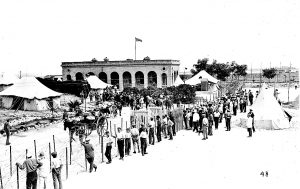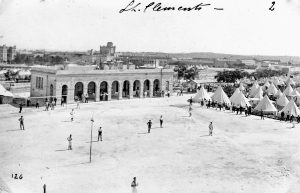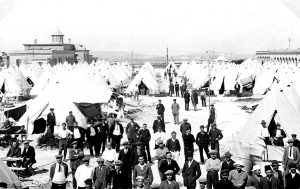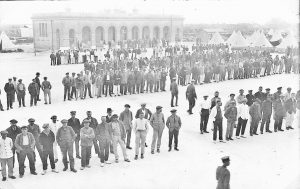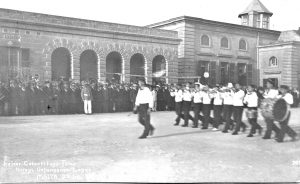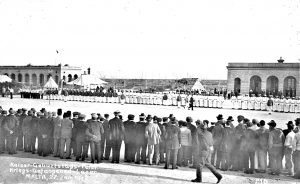The school is situated in one of the oldest historical sites of the island and its story goes as far back as the Great Siege, when the hill on which it stands served as a vantage point to the Turkish invaders to target Fort St. Michael and Fort St. Angelo. In 1638 the first stone was laid for the Firenzuola Lines, which eventually became know as the Margherita lines, with Verdala Gate, opposite the present school entrance, being the oldest part of these walls. In 1853 the British built the Verdala barracks behind this gate and later constructed a big fortress right across these barracks. It is on the grounds of this fortress that the school now stands. Starting out first as a state primary school (1924), then housing a dockyard class which provided students for the naval dockyard, it was later (1948) converted into a school for the children of British servicemen.
Verdala’s metamorphosis from a military installation to an educational one was completed when in 1972 it became The International School of Malta, catering for children of people employed overseas in the oil industry, and later also opening its doors to local students. 1984 and 1985 saw the concluding phase of this metamorphosis when the school became, first an area secondary school, and eventually, a Junior Lyceum, named after the local naturalist and ornithologist, Guzeppi Despott (1878-1936).
A Brief History of the Verdala Fortress in Cospicua, Malta
(Historical Research Article 2013)
The outer ring of fortifications in Cospicua surrounding the Santa Margerita Lines is known as the Cottonera Lines and these date back to 1670. They are so extensive that their construction exceeded the resources of the Knight’s Order and were never completed.
The Fort Verdala and the St.Clements’s Retrenchment were improvements the British built to span the undefended area between these two lines of fortifications. Fort Verdala has a unique structure, as one of its walls was incorporated into the 17th century Santa Margerita Lines to serve as a stronghold within the vast area of ground enclosed by the Firenzuola (Santa Margerita) and Cottonera enceintes.
By 1886 the Fort was armed mainly with 24 pounder smooth-bore Howitzers. This armament was removed in the 1890’s and thereafter the Fort was used as a large barrack complex to accommodate military personnel. It was also used as POW camp during WW1. After World War 2 it was used as naval stores. The extensive casemated barracks block of Fort Verdala is utilized today for public housing.
- Verdala Infants 1952
- Thought-to-be the St Clement’s Choral Society Meeting in the Club Room or Gym – photograph by Hiesinger
- An Overview of St Clement’s Camp looking from Verdala
- The Access Way into St Clement’s – photograph attributed to Hiesinger
- St Clement’s Football Match – photograph by Hiesinger
- A View of Man Tents looking towards the Verdala – photograph by Kofler
- A Formal Roll Call with Officers Inspecting
- 27 January 1917 – St Clement’s Parade Ground with Brass Band and Drums
- Tents
- 27 January 1917 St. Clement’s – Kaiser’s Birthday Gymnastics Display Team Line-up
Fort Verdala During World War 1
Malta’s role serving as a Prisoners of War camp mostly German and pro-German Austrian, Egyptian and Turkish prisoners – is history’s missing link. The most well-known German and Turkish POW’s were held in Malta, some for months while others for years or until the end of the war. The British used Malta as a huge concentration camp, an important role almost forgotten in the historic events of the first great world war.
This highly secretive operation by the British kept the Maltese in the dark. So much so, that even people living in the surrounding houses in Cospicua had no idea who the prisoners at Verdala Barracks were. The surrounding tent camps in the Cottonera area were completely cut off and no communication was allowed between camps. Some of the most illustrious German officers were locked up at the Verdala fortification in Cospicua. Other German sailors and soldiers were kept in tents outside Cospicua in St Clements’s Camp and at San Salvatore bastions in Kalkara.
Food was poor and the tents were not protective. Some Germans POW died from excessive heat or cold during their imprisonment in Malta. These were buried in the Kalkara War Graves cemetery. Two of the most famous German Navy captains who were imprisoned at Verdala were Franz Joseph Prinz von Hohenzollern and Karl Fredrick Max von Muller, the captain of the German raider ship “Emden” that sank many allied ships in the Far East. In Germany, Franz Joseph Prinz von Hohenzollern was a national hero. A postal stamp was issued in his honour. Being the first cousin of the German Kaiser, the British kept him in high esteem. His sister was the queen of Portugal.
Muller’s legendary ship, the “Emden”, was surrounded and scuttled on an island off Indonesia. He was secretly shipped to Malta on a British navy ship. He received a hero’s welcome from his fellow prisoners when he arrived at Verdala. Military and civilian prisoners considered him a great German hero. The British used the presence of Muller Franz Joseph Prinz von Hohenzollern at Fort Verdala as a propaganda ploy. They were both given their own room on an upper storey rather than a cell. They were free to exercise, write, keep domestic animals and mix with other prisoners. However, they refused these privileges knowing that their crews were held in terrible conditions outside Verdala. One German officer even had a chandelier fixed in his room. Through their influence, German officers were even allowed to print a magazine in German which they titled “Camp Nachrichten”. It was distributed to all prisoners at Verdala. The hand printed magazine often poked fun at their British captors with fine line drawings and text in the German language.
During the first months, security was very flexible. Most guards were Maltese soldiers and some prisoners were even escorted to visit Valletta for a short time. But all this changed when two prisoners, one German and one Austrian, escaped and disappeared from Malta. The British also discovered that some German prisoners were noting all naval movements in the Grand Harbour and somehow were sending the sensitive information back to Germany. Following this discovery, all windows with a panorama of the Grand Harbour were barred and covered.
The Germans protested with the British camp commandant and constantly complained about poor quality of food, lack of water and mail delivery from Germany. Some of these mass protests were so loud, that they could be heard as far as Valletta, where people complained they could not sleep because of the noise created by the German prisoners at night.
Karl Donitz another German officer also imprisoned at Verdala kept a low profile and more to himself. A young proud submarine captain, he spent his time locked up at Verdala barracks plotting to launch the feared U-Boat wolf pack tactics in case of another war. Under his command, during Second World War, hundreds of allied ships were sunk by German U-boats and 30,000 allied sailors and civilians were killed.
Ambitious and proud, Karl was to become a Grand Admiral and eventually Adolf Hitler’s successor after the Fuehrer committed suicide; a title he held just for 20 days, before his imprisonment by the victorious Allies. His connection with Malta during the First World War is an intriguing story of sheer courage and determination. An unbeaten German officer who lost his submarine and some of his crew in the Mediterranean, Donitz’s war exploits are still followed by thousands of people. On the internet site YouTube, there is a rare interview with Karl Donitz which was probably filmed some time before his death in Hamburg on Christmas eve of 1980. He explains that he was the captain of UB 68 when his submarine attacked a British convoy off Gozo. “It was a dark night on October 4, 1918 when we attacked and sank a British cargo ship. But as a single submarine we became too exposed and were hit and had to abandon the sub and scuttle her.” His chief engineer and six other crew members voluntary stayed in the sub to die for their Fatherland in order to make sure that the sub sank and did not fall in the enemy’s hands. “During my nine months imprisonment (in Malta), it dawned to me that submarines are more effective if they attack as a group.”
Secretive from his British captors, he continued to developed new tactics while a prisoner at Verdala. During WW2, under Donitz’s command, now an admiral, U-Boats were the most feared German weapons. They became known as the “wolf packs”.
But how did Donitz behave during his imprisonment at Verdala? Marc James Small from the Marine History Information Group mentions that Donitz was imprisoned in Malta when his submarine was sunk by the British some miles off the island. In prison he managed to convince the authorities that he was insane by playing with china dogs he purchased in the camp canteen. He was repatriated but arrived home too late to play a further role in WW1. Many believe that Donitz’s innocent looking toys helped him to plan his wolf pack submarine tactics. Before his death, although beaten by old age, Donitz stated that he had no regrets and would do the same if he had another chance, despite the fact that he lost both his sons in submarine warfare. Three out of every four German U-Boats never returned and were lost with their young crews. Many believe that considering the situation, the German U-boats fought hard but fair, and Donitz was punished for being too efficient.
In the Nuremberg trials, Donitz was accused of war crimes. He served 11 years and 8 months in Berlin- Spandau prison, quite a huge contrast from his previous prison in Malta. After his release in 1956, he went to live in a quite village outside Hamburg.
The only Maltese who can recall that he met Donitz is marine historian and owner of the only private marine museum in Malta, Victor Wickman. “Yes, I met him briefly. In his old age, he still showed the same pride of his golden sea sagas. He told me that he still remembers when he was a prisoner of war in Malta. He did not try to go into details, but he appreciated that he was treated quite well at Verdala Barracks.”
Another person, Stephen Petroni is a great collector of German war ‘souvenirs’, from old German patrol armed carriers to army uniforms and armaments used by German forces during the WW2. He has a collection of unique valuable rare documents connected with Verdala Barracks when used as prisoners of war camp during WW 1. Through his initiative, he wanted to reserve part of the Fort, still neglected and used as a rubbish dump, for restoration and exhibition projects. Stephen is convinced that if the true historical facts of Verdala’s role in the First World War are known in Germany, thousands will visit Malta just to see where their great grand German ancestors, captains and admirals were held as POW’s. However, he found no response from the local Government Authorities.
After more than 80 years, the huge building of Verdala has stood the test of time. The entrance door of the old fortifications is in a state of deep erosion, but the huge bastions and the inside quarters are reasonably in good conditions. From the outside, one can still see the thick iron bars that blocked the outside bastion windows. One wonders how many secrets were locked amongst the prisoners held on the inside. The grounds where the prisoners paraded and spent their free time is still there but covered with tarmac. The granite steps and stairs that lead to the upper cells are still original. When the barracks were transformed into a housing estate for Maltese families, the barracks suffered from constant rape of its original fortifications. No voices of protest were ever heard. Many facades were painted in different colours and aluminium doors and windows replaced the originals. Most residents were permitted to connect rooms destroying original walls to make room for bigger premises. It may be far too late to restore Verdala Barracks back to its old glory and its rightful place in the history books. As years rolled on, all captors and captives are all gone. For generations to come, there is not even one trace or memory dedicated to the illustrious German prisoners who walked the corridors of Verdala during their captivity in Malta. Some of the prisoners of Verdala changed the course of world history, but their presence at Verdala and other POW camps in Malta is completely forgotten.
Research article by Mr Martin Azzopardi sdc, school archivist




